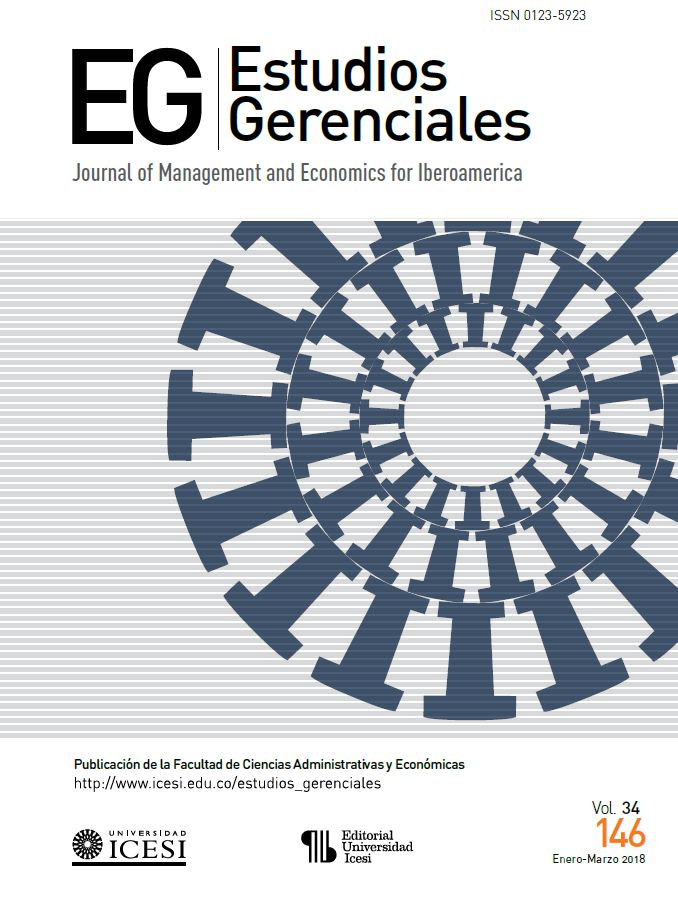Risk assessment methodology: implementation of duration gap in corporate portfolios in order to reduce the systemic risk
DOI:
https://doi.org/10.18046/j.estger.2018.146.2659Keywords:
Key risk indicator, Convexity, Duration, Duration gap, ImmunizationAbstract
In this article we propose a new methodology for measuring companies with financial risk exposure, based on the concept of duration in assets and liabilities management that can be applied in corporate portfolios. Risk indicators in banks usually try to measure the dynamic of accounts in the income statement and capital levels. With this research, we demonstrate how the methodology can be applied from banks to any company or industry sector. Then, we compare the methods for managing accounts in financial institutions and also identifying their adaptability to any type of corporation. We also made a comparison between the management elements used in financial markets and organizations assets, verifying their adaptability level. Finally, we present a real case study.
Downloads
References
Albuquerque, R., Eichenbaum, M., Rebelo, S., & Luo, V. (2016). Valuation Risk and Asset Pricing. The Journal of Finance, 71(6), 2861 - 2904.
Armeanu, D., Balu, F. O., & Obreja, C. (2008). Interest rate risk management using duration gap method¬ology. Theoretical and Applied Economics, 518(1), 3-10.
Augustin, L., Sraer, D., & Thesmar, D. (2013). Banks' exposure to interest rate risk and the transmission of monetary policy. National Bureau of Economic Research, 1(187), 157 - 180.
Beck, K., Goldreyer, E., & D'Antonio, L. (2000). Duration gap in the context of a banks strategic planning process. Journal of Financial and Strategic Decisions, 13(2), 57-71.
Bierwag, G., & Kaufman, G. (1985). Duration gap for financial institutions. Fi¬nancial Analysts Journal, 41(2), 68-71.
Bierwag, G. (1987). Duration analysis: man¬aging interest rate risk. Ballinger Publishing Company, 4(2), 264 - 287.
Bierwag, G., Kaufman, G., & Toevs, A. (1983). Duration: its develop¬ment and use in bond portfolio manage¬ment. Financial Analysts Journal, 39(4), 15-35.
Blundell Wignall, A., & Atkin¬son, P. (2010). Thinking beyond basel III: necessary solutions for capital and liquidity. OECD Journal: Financial Market Trends, 1(1), 9 - 33.
Bodie, K., Kein, A., & Marcus, A. (2002). Princi¬ples of investments. Moscow: Ed. Williams.
Bouchaud, J. P., & Potters, M. (2003). Theory of financial risk and derivative pricing: from statistical physics to risk management. Cambridge: Cambridge University Press.
Copeland, T., Koller, T., & Murrin, J. (2000). Valuation: measuring and managing the value of companies. New York: McKinsey & Company Inc.
Duan, J. C., Moreau, A., & Sealey, C. (1995). Deposit insurance and bank interest rate risk: Pricing and regulatory implications. Journal of Banking & Finance, 19(6), 1091 - 1108.
Duffie, D., & Garleanu, N. (2001). Risk and valuation of collateralized debt obli¬gations. Financial Analysts Journal, 57(1), 41 - 59.
Dumrauf, G. (2013). Finanzas Corporativas. Buenos Aires: Editorial Alfaomega.
Erb, C., Harvey, C., & Viskanta, T. (1996). Political risk, economic risk, and financial risk. Financial Analysts Journal, 52(6), 29 - 46.
Fabozzi, F., & Mann, S. (2012). The handbook of fixed income securities. New Jersey: McGraw Hill Professional.
Fabozzi , F., & Modigliani, F. (2003). Capital markets: institutions and instruments. New Jersey: Pearson College Division.
Fernandez, P. (2008). Metodos de valoración de empresas: PricewaterhouseCoopers Professor of Corporate Finance. Madrid: IESE Business School.
Grable, J. (2000). Financial risk tolerance and additional factors that affect risk tak¬ing in everyday money matters. Journal of Business and Psychology, 14(4), 625-630.
Hjortsø, I. (2016). Imbalances and fiscal policy in a monetary union. Journal of International Economics, 102(2), 225 - 241.
Hull, J., Treepongkaruna, S., Colwell, D., Heaney, R., & Pitt, D. (2013). Fundamentals of futures and options markets. Toronto: Pearson Higher Education.
Jorion, P. (1991). The pricing of exchange rate risk in the stock market. Journal of financial and quantitative analysis, 26(3), 363-376.
Kanchu, T., & Kumar, M. (2013). Risk Management in Banking Sector–an Empirical Study. International Journal of Marketing, Financial Services & Management Research, 2(2), 145 - 158.
Knop, R., de Castro Riesco, M., & Fernandez, J. M. (2006). Manual de instrumentos de renta fija: estructurados de tipos de interes y crédito. Madrid: Ariel.
Lai, Y. J., & Hwang, C. L. (1993). Possibilistic linear programming for manag¬ing interest rate risk. Fuzzy Sets and Sys¬tems, 54(2), 135-146.
Manco, O., Botero, O., & Medina, S. (2016). Risker: Platform Implementation of Complex System Model for Financial Risk Management in Energy Markets. Procedia Computer Science, 83(1), 1078 - 1083.
Martinez Abascal, E., & Guasch Ruiz, J. (2002). Gestion de carteras de renta fija. Madrid: McGraw-Hill Interamericana de España.
Narayana, A., & Mahadeva, K. (2016). Risk Management in Banking Sector-An Empirical Study. Imperial Journal of Interdisciplinary Research, 2(8), 50 - 62.
Neftci, S. (2008). Principles of financial engi¬neering. London: Academic Press.
Piterbarg, V. (2006). Tarns: Models, valu¬ation, risk sensitivities. The Best of Wilmott, 153(2), 153-178.
Power, M. (2008). Organized uncer¬tainty: Designing a world of risk manage¬ment. New York: Oxford University Press .
Qingle, B. Z., & Jie, L. (2001). Fundamental issues of business valuation for high-tech enterprises. The Journal of Assets Ap¬praisal, 6(1), 64-90.
Saunders, A., Cornett, M. M., & McGraw, P. A. (2006). Financial institutions management: A risk management approach. New York: McGraw-Hill/Irwin.
Smithson, C. W., Smith, C., & Wilford, D. (1989). Managing financial risk. Journal of Applied Corporate Finance, 1(4), 27-48.
Stone, B. (1974). Systematic interest-rate risk in a two-index model of returns. Jour¬nal of Financial and Quantitative Analysis, 9(5), 709-721.
Vyadrova, N. (2015). The bank strategy in the assets and liabilities management. Economics, Management, law: problems and prospects, 38(4), 18-30.
Published
Issue
Section
License
Articles are the sole responsibility of their authors, and will not compromise Icesi’s University principles or policies nor those of the Editorial Board of the journal Estudios Gerenciales. Authors authorize and accept the transfer of all rights to the journal, both for its print and electronic publication. After an article is published, it may be reproduced without previous permission of the author or the journal but the author(s), year, title, volume, number and range of pages of the publication must be mentioned. In addition, Estudios Gerenciales must be mentioned as the source (please, refrain from using Revista Estudios Gerenciales).








